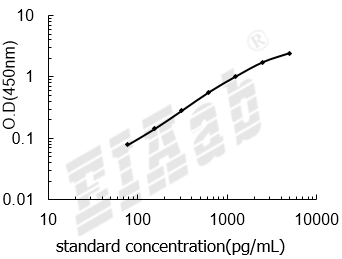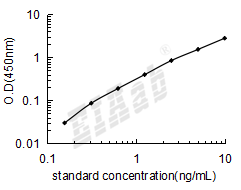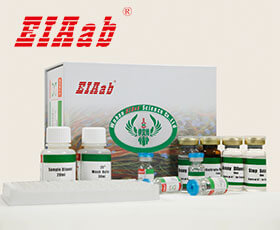S100a9 (基因名), Protein S100-A9 (蛋白名), s10a9_mouse.
产品名称:
Mouse S100a9/ Protein S100-A9 CLIA Kit
S100钙结合蛋白A9/钙粒蛋白B
货号:
U1793m
商标:
EIAab®
监管等级:
别名:
Calgranulin-B, Leukocyte L1 complex heavy chain, Migration inhibitory factor-related protein 14, S100 calcium-binding protein A9, MRP-14, Cagb, Mrp14
检测方法:
CLIA
实验类型:
Sandwich
检测范围:
7.8-500pg/mL
特异性:
Natural and recombinant mouse Protein S100-A9
样品类型:
Serum, plasma, tissue homogenates, cell culture supernates and other biological fluids
样品数据:
登录.
研究领域:
Immunology
通用注释
亚单元:
Homodimer. Preferentially exists as a heterodimer or heterotetramer with S100A8 known as calprotectin (S100A8/A9). S100A9 interacts with beta-APP40 (beta-amyloid protein 40) peptide of APP (By similarity). S100A9 interacts with AGER and the heterodimeric complex formed by TLR4 and LY96 in the presence of calcium and/or zinc ions. S100A9 binds quinoline-3-carboxamides in the presence of calcium and/or zinc ions. S100A9 interacts with ATP2A2. Calprotectin (S100A8/9) interacts with NCF2/P67PHOX, RAC1, RAC2, CYBA and CYBB (By similarity). Heterotetrameric calprotectin (S100A8/A9) interacts with ANXA6 and associates with tubulin filaments in activated monocytes (By similarity). Calprotectin (S100A8/9) interacts with CEACAM3 and tubulin filaments in a calcium-dependent manner. Calprotectin (S100A8/9) interacts with NOS2 to form the iNOS-S100A8/A9 transnitrosylase complex.
功能:
S100A9 is a calcium- and zinc-binding protein which plays a prominent role in the regulation of inflammatory processes and immune response. It can induce neutrophil chemotaxis, adhesion, can increase the bactericidal activity of neutrophils by promoting phagocytosis via activation of SYK, PI3K/AKT, and ERK1/2 and can induce degranulation of neutrophils by a MAPK-dependent mechanism. Predominantly found as calprotectin (S100A8/A9) which has a wide plethora of intra- and extracellular functions. The intracellular functions include: facilitating leukocyte arachidonic acid trafficking and metabolism, modulation of the tubulin-dependent cytoskeleton during migration of phagocytes and activation of the neutrophilic NADPH-oxidase. Activates NADPH-oxidase by facilitating the enzyme complex assembly at the cell membrane, transferring arachidonic acid, an essential cofactor, to the enzyme complex and S100A8 contributes to the enzyme assembly by directly binding to NCF2/P67PHOX. The extracellular functions involve proinfammatory, antimicrobial, oxidant-scavenging and apoptosis-inducing activities. Its proinflammatory activity includes recruitment of leukocytes, promotion of cytokine and chemokine production, and regulation of leukocyte adhesion and migration. Acts as an alarmin or a danger associated molecular pattern (DAMP) molecule and stimulates innate immune cells via binding to pattern recognition receptors such as Toll-like receptor 4 (TLR4) and receptor for advanced glycation endproducts (AGER). Binding to TLR4 and AGER activates the MAP-kinase and NF-kappa-B signaling pathways resulting in the amplification of the proinflammatory cascade. Has antimicrobial activity towards bacteria and fungi and exerts its antimicrobial activity probably via chelation of Zn(2+) which is essential for microbial growth. Can induce cell death via autophagy and apoptosis and this occurs through the cross-talk of mitochondria and lysosomes via reactive oxygen species (ROS) and the process involves BNIP3. Can regulate neutrophil number and apoptosis by an anti-apoptotic effect; regulates cell survival via ITGAM/ITGB and TLR4 and a signaling mechanism involving MEK-ERK. Its role as an oxidant scavenger has a protective role in preventing exaggerated tissue damage by scavenging oxidants. The iNOS-S100A8/A9 transnitrosylase complex is proposed to direct selective inflammatory stimulus-dependent S-nitrosylation of multiple targets such as GAPDH, NXA5, EZR, MSN and VIM by recognizing a [IL]-x-C-x-x-[DE] motif.
亚细胞位置:
Secreted
Cytoplasm
Cytoplasm
Cytoskeleton
Cell membrane
Peripheral membrane protein
Predominantly localized in the cytoplasm. Upon elevation of the intracellular calcium level, translocated from the cytoplasm to the cytoskeleton and the cell membrane. Upon neutrophil activation or endothelial adhesion of monocytes, is secreted via a microtubule-mediated, alternative pathway.
该产品尚未在任何出版物中被引用。
反馈墙
评论数 : 0
所有用户
所有用户
默认排序
默认排序
最近
早期
目前还没有评论。






通知
规格
数量
单价 (¥)
小计 1 (¥)
小计 2:
¥

规格
数量
单价 (¥)








 验证序列:
验证序列:




 折扣:
折扣: